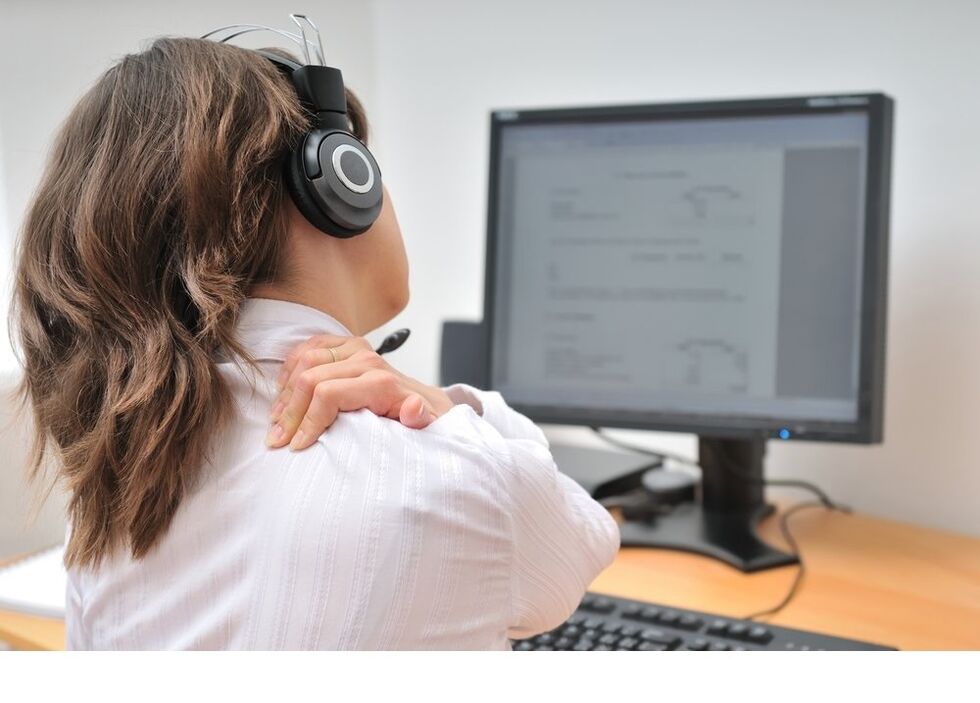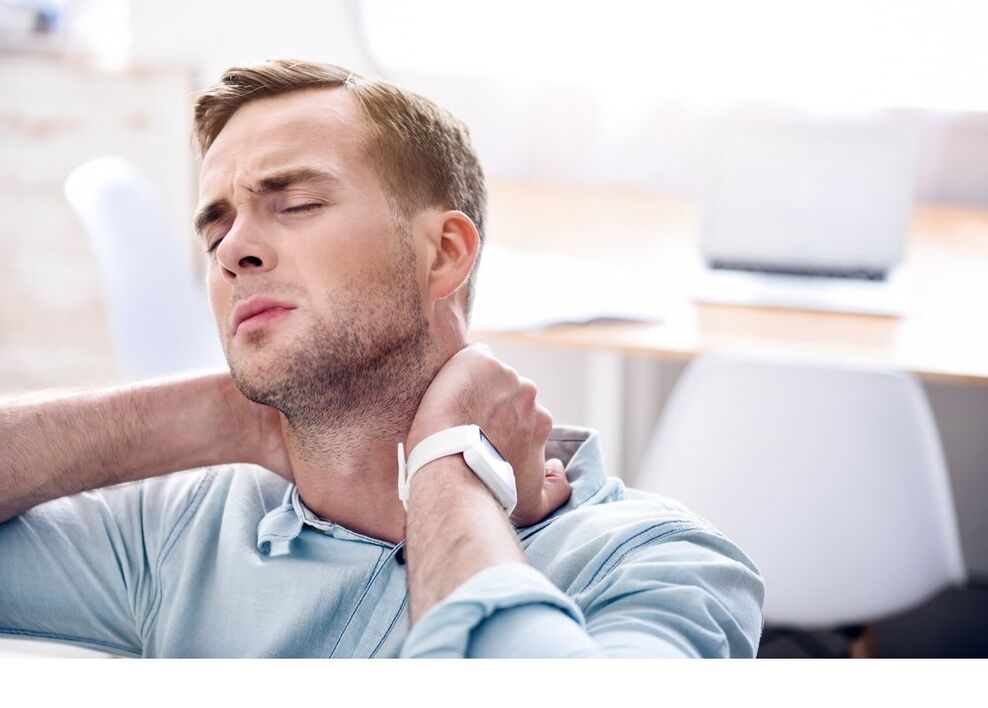The symptoms of neck pain are familiar to everyone: it pulls the muscles, it is impossible to tilt and turn your head, and looking to the side requires turning your whole body. As a rule, the culprit is the spine: injuries, hernias, scoliosis lead to the fact that a person feels pain in the back and neck. The discomfort lets him treat himself. However, if the pain radiating to the neck does not go away after home therapy, the next step is to see a doctor.
Neck pain in adults
Neck pain in women

Neck pain during pregnancy
Back and neck pain is often a concern for expectant mothers. The explanation is simple - with a change in weight and proportions of the body, posture changes, the load on the spine increases.
How do you deal with this anger? A special pregnancy bandage helps to keep your back in the right position. To strengthen the back and neck muscles, it makes sense to do swimming and yoga (with the permission of an obstetrician-gynecologist, of course). You need to sleep in a comfortable position with a firm mattress and a low pillow. But the most important thing is to consult a doctor, since any self-medication can negatively affect the condition of the mother and the unborn child.
Neck pain in young mothers
Back and neck pain are common among young mothers. The matter is made more difficult by the fact that a woman cannot take many medications while breastfeeding, as pollutants get into the milk. How can you help yourself and prevent the pain in the neck area from affecting the baby's joy?
- Monitor your posture. When carrying a child, the center of gravity shifted with an increase in the abdomen - you had to bend back to maintain balance, and the shoulders were tense all the time.
- Do not overwhelm yourself physically, try to properly distribute the load on your back. Various baby carriers can help with this. They distribute the child's weight over both shoulders and prevent back and neck fatigue.
- Baby care items must be adjusted according to their body size so that they do not stand in an uncomfortable position for long.
- It is very important to find a comfortable position while breastfeeding, especially at night.
Neck pain in men

Neck pain usually doesn't differ by gender - it can occur in both men and women. And yet there are some differences in anatomy: the male neck is decorated with a pronounced Adam's apple - a thickening of the thyroid cartilage, the plates of which are oblique to each other.
Pain in the Adam's apple in men can indicate a rather serious illness:
- Thyroiditis is inflammation of the thyroid gland. With thyroiditis, patients worry about pain in the neck when turning, pain in the Adam's apple, above and below it, swelling of the neck.
- Cancer of the thyroid cartilage - its danger lies in the fact that the onset of the disease can resemble a cold: a sore throat when swallowing, it is difficult to turn your throat and even breathe.
- Phlegmon of the thyroid cartilage is an extensive suppuration of the cartilage and soft tissues of the neck that is life threatening. The patients complain of chills and high fever, pain when swallowing, loss of voice, and difficulty breathing.
- Cartilage tuberculosis usually occurs with existing pulmonary tuberculosis and is its complication.
- Kadik may have osteochondrosis. Failure to do so causes pain when swallowing, sneezing, and coughing.
- Fractures, bruises, and compression of the cartilage can cause displacement, swelling of the neck, and choking.
Neck pain in the elderly
Pain radiating to the neck in the elderly may indicate the development of diseases:
- Cancer of the apex of the lung (cancer with Pancost and Horner syndrome). The patient's pain in this case is associated with the growth of the tumor in the nerve endings of the shoulder girdle and neck.
- Tumors of the neck, salivary glands.
- Coronary heart desease. The pain can spread from the chest to the neck and arms, causing symptoms similar to osteochondrosis.
- Polymyalgia rheumatica is an inflammatory disease characterized by stiffness and pain in the muscles of the shoulder girdle and hips.
- Spinal metastases in various oncological diseases (it's no secret that the likelihood of developing cancer increases with age).
- Subluxation of the cervical vertebra as a complication of rheumatoid arthritis.
- The most common causes of neck pain in the elderly are osteoarthritis and osteochondrosis of the spine, rheumatoid arthritis, and chronic inflammation of the connective tissue.
Neck pain in children

Severe neck pain in children occurs for the same reasons as in adults:
- trauma
- Osteochondrosis
- Stress and anxiety
- Tumors
- Diseases of other organs causing distant pain
Perhaps the most specific "child" cause of neck pain is torticollis, when the child's head is turned sharply to one side. Torticollis is dangerous because it leads to a curvature of the cervical spine and disrupts the formation of the facial skeleton.
Contrary to popular belief, the disease does not only appear during childbirth. Depending on how torticollis occurred, a distinction is made between the following types:
- Congenital - it can happen in the womb if the fetus is not properly positioned, but most often it happens during childbirth when the baby turns his head to one side and injures the neck muscles.
- Dermatogenic - when the neck is twisted from the scars left by trauma or burns.
- Reflex - it happens with injuries, otitis media, diseases of the salivary gland.
- Neurogenic - due to muscle spasms after polio or encephalitis.
- Spastic - due to excessive tension in the muscles of the neck.
- Traumatic - associated with a fracture of the spine.
Torticollis (with the exception of dermatogenic and neurogenic) is usually seen in newborns or manifests itself within the first few months. The greatest risk of their occurrence arises when:
- The fetus during natural labor is in the breech position.
- The position of the fetus in the mother's abdomen is such that the uterine wall presses on the neck.
- Birth is difficult, and the baby's mastoid muscle is damaged (with scarring).
- It becomes necessary to use tweezers and vacuum for difficult work.
- The mastoid muscle becomes inflamed during intrauterine development, as a result of which muscle tissue has been replaced by fiber tissue in the area of inflammation.
- The mastoid muscle is pathologically hypertrophied and shortened.
- With caesarean section.
How can you cure torticollis?
- The conservative method consists of a massage and physiotherapy course, a special orthopedic head contouring of the baby, wearing an orthopedic collar and gymnastic exercises.
- Operation - is carried out when conservative methods have not brought results. During the operation, the surgeon extends the sternocleidomastoid muscle and straightens the position of the child's head.
Different types of neck pain
Sharp neck pain

Why is there a sharp pain in the neck? There are two reasons:
- Trauma (fracture, blow, bruise).
- Injury to nerve endings - this is the case with osteochondrosis, herniated disc, compression of the spinal canal.
Treatment for pain depends on the cause and includes:
- Prescribing pain medication.
- Muscle relaxants and anticonvulsants used to relieve muscle spasms.
- Immobilization (immobilization) of the cervical spine.
- Exercise therapy and physiotherapy.
Severe neck pain
Severe neck pain is always uncomfortable. I want to quickly find out why it hurts and recover. What are the causes of severe pain?
- Worsening of osteochondrosis, when unsuccessful movement, rotation or jarring of the body causes displacement of the vertebrae, injury to an existing hernia, compression of the spinal nerves.
- Cervical radiculitis (inflammation and pinching of the spinal roots).
- Cervicago - "lumbago" (sharp, severe muscle spasms).
- Severe back and neck pain can occur after an injury.
Neck pain in osteochondrosis
Neck pain in osteochondrosis is very severe and gives the patient many uncomfortable minutes. Muscle spasms or displacement of the vertebrae towards one another can pinch or twist arteries that supply the brain. In the most severe cases, this can lead to a state similar to a suggestion, when a person is dizzy, everything is floating in front of their eyes, sometimes speech and eyesight is lost.
Neck pain on the left

Left neck pain is a possible symptom of problems not only in the cervical spine but also outside it. What can a person have when they have left neck pain?
- Heart disease (heart attack, coronary artery disease, angina pectoris).
- Upper left lung cancer.
- Injuries.
- Metastases of tumors from other organs into the nodes on the left side of the neck.
- Infectious inflammation of the lymph nodes (due to tonsillitis, ARVI, tonsillitis).
Neck pain on the right
Pain in the neck on the right is an alarming symptom, but most often it is explained banally: a person has osteochondrosis, with all the consequences that arise from it. Such consequences are nerve entrapment, muscle spasms, intervertebral protrusion and hernia, vascular diseases.
But there are other causes of neck pain on the right side as well:
- Biliary colic radiating to the neck and shoulder.
- Right-sided apical lung cancer with tumor invasion of the overlying nerves.
- Bruises, injuries, fractures of the collarbone and vertebrae.
- Cervical spine tumors (metastases from other organs).
- If the pain is concentrated in the front right side of the neck, this may also indicate heart problems (heart attack, coronary artery disease).
- Inflammation of the lymph nodes from ARVI and sore throat.
Neck and shoulder pain

Pain in the neck and shoulder area is a classic sign of cervical osteochondrosis and its accompanying complications (injury to the hernia, nerves, spinal cord). In addition, simultaneous pain in the neck and shoulders is a symptom of such diseases:
- Gallstone disease during an exacerbation with biliary colic.
- Heart disease.
- Osteoarthritis of the shoulder.
- Cervical plexitis is inflammation of the large nerve nodes of the spinal nerves.
- Periarthritis of the shoulder and scapula - inflammation of the tendons of the shoulder and capsules of the shoulder joints.
- Myositis.
- Arthritis.
Neck and back pain
Neck and lower back pain is usually a sign of widespread osteochondrosis that has affected the entire spine. After all, it doesn't happen that posture is good in one part of the spine and bad in the other. In osteochondrosis, neck pain is mild when the disease is in remission and severe, painful when it has worsened. The exacerbation begins with a sharp pain in the neck and back with an unsuccessful twist, movement, impact. It can be removed with the help of medication prescribed by the doctor, rest, light warmth on the affected area, exercise therapy, and physical therapy.
Neck and neck pain
Most often, pain in the neck and back of the head is a symptom of mundane cervical osteochondrosis - a dangerous disease, but not fatal. But sometimes it indicates meningitis, and this disease poses a threat to human life. The causative agents of meningitis - bacteria and viruses - invade the brain and spinal cord and cause their membranes to become inflamed.
Numbness, pain in the neck and back of the head, stiffness of the occipital muscles, the inability to pull the head towards the chest at the same time, bend the leg at the knee - all these are meningeal symptoms that immediately alert the doctor. Treatment of a dangerous disease is carried out in a hospital,
In addition to meningitis and osteochondrosis, pain in the neck and back of the head can also be caused by injuries, neuralgia of the occipital nerve, high blood pressure and muscle strains.
Causes and Symptoms of Neck Pain
trauma

Sometimes the cause of neck pain becomes an injury that dislocates or ruptures the cervical vertebrae, damaging the spinal nerves. Injuries can occur from accidents, falls, injuries, poor diving, or sudden movements. Symptoms of a neck injury are:
- Incorrect neck flexion, inability to turn the head, chest and neck muscle tension indicate a fracture of the lower vertebrae.
- Pain in the vertex and back of the head is an indicator that the 1st cervical vertebra is damaged.
- Swelling and "bruising" can result from a neck injury.
- Pain in the neck when turning the head, in the shoulders, in the upper chest area, aching headache is a symptom of whiplash caused by alternately bending and stretching the neck sharply (this can happen if the vehicle is suddenly braked).
Neoplasms

An extremely dangerous cause of neck pain is a malignant neoplasm. How can it be?
- Neck pain as a symptom of a tumor in the upper part of the lungs. It causes nerve bundles and blood vessels to sprout, causing severe pain. Depending on the location of the tumor, a person can experience neck pain on the left or right.
- A symptom of neck pain sometimes indicates the development of lymphoma - cancer of the lymph nodes. Since many lymph nodes are concentrated on the neck, they grow as the disease progresses and it is difficult not to notice. Other prominent signs of lymphoma include excessive sweating, a seemingly unreasonable fever, and weight loss.
- Salivary gland cancer is a tumor that affects the salivary glands behind the ears, on the sides of the neck, and in the roof of the mouth. At its early stages it is painless, only sometimes you may notice seals in the affected glands.
- A tumor of the larynx grows into its walls, visually represents a nodular neoplasm. They are difficult to detect during a routine examination, so cancer is unfortunately diagnosed late when other manifestations become visible: foreign body sensation in the throat, hoarseness and roughness of the voice, difficulty breathingthe nose. A tumor of the larynx is also dangerous because it is prone to the early appearance of metastases, which greatly worsens the prognosis of the patient's recovery.
- Thyroid cancer presents with nodular lumps, anterior neck pain, and voice changes.
- With thyroid cartilage cancer, patients complain of swallowing and movement difficulties in the larynx, a foreign body sensation or a lump in the throat.
Reflected pain in diseases of other organs
The pain radiating to the neck doesn't always indicate that the problem is in the neck itself. Sometimes it hurts because other organs are sick, and then the pain is said to be reflected. What diseases can it cause?
- Heart disease (ischemic heart disease, myocardial infarction, angina pectoris) - they are accompanied by seizures, when the pain radiates to the shoulders, neck, sometimes arm.
- Pain in the right neck, under the right shoulder blade, and right shoulder occurs during a bile colic attack with stones in the gallbladder.
- Diseases of the esophagus (reflux, erosion, ulcer).
- Oncological diseases (lymphoma, tumor metastases) are the cause of human suffering when the neoplasm affects the nerve endings. For example, cancer of the tip of the lung, as the tumor grows upwards, causes pain in the neck and shoulders. Intracranial tumors, head oncological diseases also cause pain in the cervical spine.
- Abscesses and phlegmon of the head.
- Bleeding into the subarachnoid space between the brain and its delicate tissues.
Mental causes of neck pain
Neck pain is often associated with muscle spasm. Spasms aren't just due to stress, injury, or injury - they can be caused by stress, nervous shock, and fatigue. Why is this happening?
The fact is that the body perceives stress as a threat to its well-being and thus mobilizes it. Stress hormones are released into the bloodstream, the heart rate increases and, on the contrary, digestion slows down. Muscle tone increases in response to hormonal changes. As soon as the alarming situation is experienced, the body goes into normal mode. However, if the emotional stress takes on a chronic form, then the muscle spasm becomes constant, and against this background diseases of the spine develop (osteochondrosis, hernia, herniated disc).
Sedentary lifestyle, frequent computer work

Pain in the neck muscles is common because a person has impaired posture, and the cause of impaired posture may be weakness in the muscle corset. This usually happens to people who are far from physical education, lead a sedentary lifestyle, and do a lot of computer work. To make matters worse, the workplace is often not properly organized and the person sits stooped or uncomfortably stooped. As a result, the pain radiating to the neck becomes a constant companion, the usual muscle spasms form, degenerative changes in the intervertebral discs begin, and osteochondrosis develops. And neck pain is also a constant companion with osteochondrosis: decreasing phases of pain are replaced by exacerbations, and only competent treatment, a change in lifestyle from sitting to mobile, posture control, strengthening of the neck and back muscles can break this cycle.
Diagnosis of neck pain
How to determine the causes of neck pain and determine the diagnosis
- First of all, you need to collect an anamnesis:
- Anamnesis of life. It is necessary to find out whether there has been a history of injuries to the neck and shoulder girdle, what diseases the person was sick with and which of them became chronic, whether a cold and hypothermia have recently appeared. For example, the fact of cholecystitis can explain painful sensations in the neck - with biliary colic, sometimes the pain only radiates to this area. At the same time, the cause of neck pain can be on the left: a tumor in the upper part of the left lung, muscle inflammation and compression of the spinal roots on the left.
- History of the disease - how and how it began, which doctor the patient visited, what examination and treatment he was prescribed, how it affected the course of the disease (whether it got better or worse).
- A visual examination helps in making the diagnosis - the doctor palpates the lymph nodes and muscles, checks the mobility of the head and neck, assesses the condition and color of the skin, looks for any visible damage and trauma.
- If there is a suspicion that neck and shoulder pain is due to diseases of other organs, the patient should contact a specialized specialist - oncologist, endocrinologist, gastroenterologist, cardiologist, etc.
- In other cases, radiation diagnostics will help clarify the diagnosis: MSCT, CT, X-ray.
- Sometimes electroneuromyography (ENMG), an electrophysiological examination, is a useful diagnostic procedure that determines the condition of muscles and the peripheral nervous system.
Treatment of neck pain
Medication

Medical treatment for neck pain, if it is due to cancer or problems in other organs, aims to manage the underlying disease that has been identified. When it comes to diseases of the spine and muscle tension, the following drugs can be prescribed:
- Nonsteroidal Anti-Inflammatory Drugs (NSAIDs) are used to relieve pain and reduce inflammation. NSAIDs are available in the form of tablets, injections, as well as gels and ointments. In the acute stage, both can be prescribed (several hours apart). So if just by tears you can turn your head from pain in the neck, injections and ointments will come to the rescue.
- Muscle relaxants are medicines that reduce the tone of skeletal muscles.
- Antispasmodics - drugs used to relieve smooth muscle spasms.
- B vitamins are needed to improve metabolic processes and the synthesis of neurotransmitters.
- For circulatory disorders caused by compression of blood vessels and muscles, vasodilator drugs are prescribed.
massage
Massage, used to treat neck and lower back pain, is used when the acute symptoms of the disease have subsided. The beneficial effects of massage are that it:
- Improves blood circulation in the affected area
- Relieves muscle cramps, relaxes, relieves tension and fatigue
- Removes swelling and inflammation
- Improves blood flow to the brain
- Restores the mobility of the joints
physical therapy
Physiotherapy treatment for neck pain begins at the same time as drug treatment when acute symptoms subside or remission occurs. During the acute course of the disease, only those manipulations that have an analgesic effect can be prescribed. Physiotherapy has a good effect as the effect is aimed specifically at the diseased area. Which procedures are possible?
- Electrophoresis with various drugs. Under the influence of alternating current, drugs penetrate deep into the tissue.
- Phototherapy (laser therapy) - action of light rays with a fixed wavelength on the affected part of the body.
- Magnetic field therapy is a method of treating pain under the neck and neck with an alternating magnetic field or a constant magnetic field. The method has anti-inflammatory and analgesic effects.
- Ultrasound treatment relieves neck pain and inflammation.
- Detensor therapy is a stretching of the spine by the weight of a person on a special mattress with inclined ribs. This type of physiotherapy normalizes muscle tone, relieves tension.
- The shock wave therapy (SWT) method is based on the effect of low-frequency sound waves that the human ear cannot hear. Treatment with the help of shock wave therapy allows you to relieve or eliminate pain, improve blood flow in the area of exposure of the device.
- Vibration therapy - exposure to mechanical vibrations using vibrating massagers.
- Movement therapy (physical therapy exercises) - the complex can vary from traditional gymnastics to an individual series of exercises, developed taking into account the diagnosis and the patient's condition.
Surgical intervention
Surgical treatment for neck pain is prescribed when conservative therapy has not led to the desired result:
- Pain doesn't go away with medication
- There are signs of compression of the spinal cord and roots
- Pronounced and increased weakness of the hand muscles
Most often, operations to remove disc hernias are performed simultaneously with the fusion and immobilization of adjacent vertebrae. To remove the compression of the spinal cord, a laminectomy is used - removal of part of the vertebral arch, followed by the removal of osteophytes and hernias.
After surgery and proper rehabilitation, the symptoms of neck pain no longer bother the patient.
Prevent neck pain

With neck pain, turning your head, tilting it, or lying down comfortably becomes a major problem. And when it hurts a lot, life ceases to please at all. You can prevent neck problems as a preventive measure. What do we have to do?
- Choose a comfortable sleeping position, a mattress that is firm enough, and a low pillow that will keep your shoulders from sagging.
- Observe your own posture: don't sit hunched, don't crouch.
- Do at least simple exercises on a regular basis to strengthen your neck muscles. Stretching and yoga are helpful.
- If you have a sedentary lifestyle, take breaks every hour and a half to walk, stretch, and stretch.
- Protect yourself against physical injuries: do not twist your neck too much, avoid impacts and traumatic sports stress.
- Get rid of talking on the phone by squeezing it with your ear and shoulder.
- Avoid nervous shocks, stress, and worry. Negative emotions and fear can cause stiffness, fatigue, and muscle cramps.
- It is undesirable to put weight on either shoulder as the distortion of the spine causes neck pain on the right or left.
- Avoid colds and drafts, which can cause myositis (inflammation of the neck muscles).
- Drink plenty of decaffeinated liquids. Sufficient water enables you to efficiently transport the substances and electrolytes that your muscles need.
- Eat foods that contain calcium, magnesium, sodium, and potassium. Deficiency in these substances can cause muscle cramps and neck pain.
Severe neck pain can seriously ruin your life, especially if it came at the wrong time - for example, on a long-awaited vacation. Therefore, when making the first "calls" one should not ignore the alarming signals of the body, but undergo an examination and obtain a doctor's recommendation. There is nothing wrong with remembering about prevention: moderate exercise, sleeping and working in a comfortable position, proper nutrition and weight distribution while wearing will help keep your neck healthy.















































